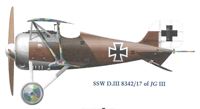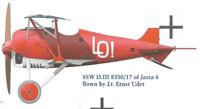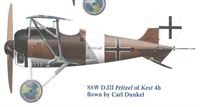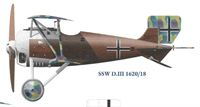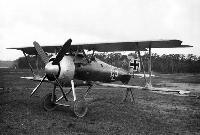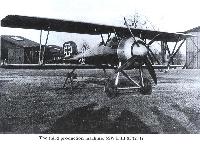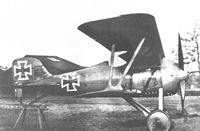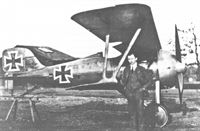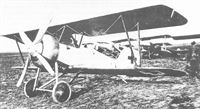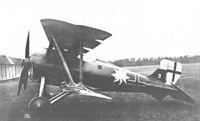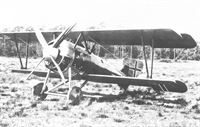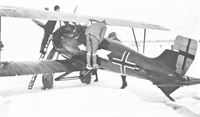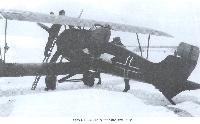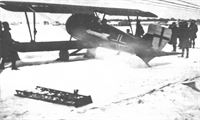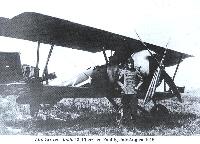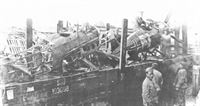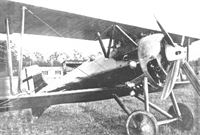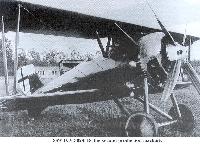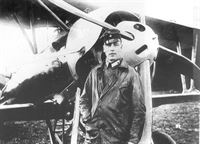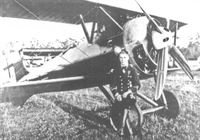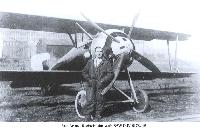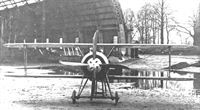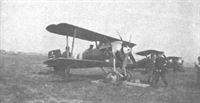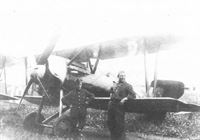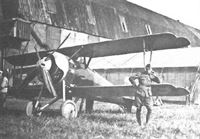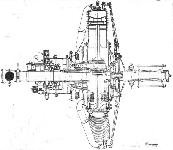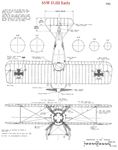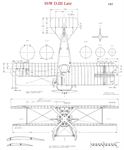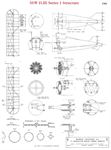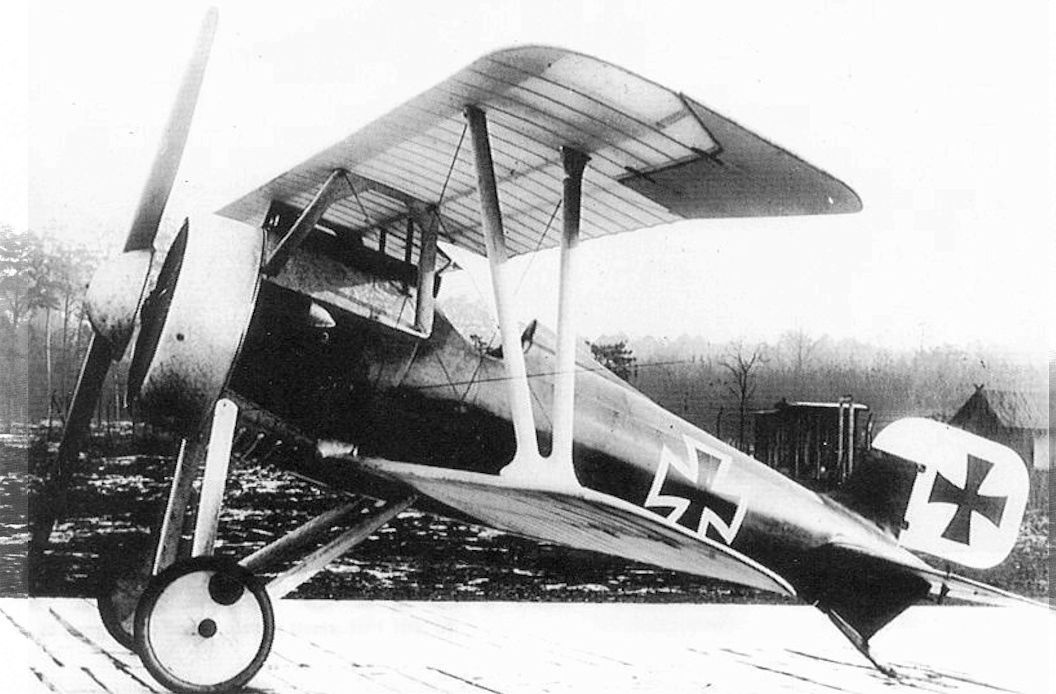
Описание
Страна: Германия
Год: 1917
Истребитель
Варианты
- Siemens-Schuckert - D.II/D.III/D.IV - 1917 - Германия
- Albatros - H.1 - 1926 - Германия
- В.Кондратьев Самолеты первой мировой войны
- O.Thetford, P.Gray German Aircraft of the First World War (Putnam)
- J.Herris Siemens-Schuckert Aircraft of WWI (A Centennial Perspective on Great War Airplanes 12)
- M.Dusing German Aviation Industry in WWI. Volume 2 (A Centennial Perspective on Great War Airplanes 85)
- W.Green, G.Swanborough The Complete Book of Fighters
- Журнал Flight
-
В.Кондратьев - Самолеты первой мировой войны
"Сименс-Шуккерт" D.III, второй серийный экземпляр в заводской окраске, весна 1918г.
-
J.Herris - Siemens-Schuckert Aircraft of World War I /Centennial Perspective/ (12)
SSW D.III 8341/17, the second production D.III, was sent to JGIII on March 16, 1918
-
J.Herris - Siemens-Schuckert Aircraft of World War I /Centennial Perspective/ (12)
SSW D.III 8342/17 of JG III
-
J.Herris - Siemens-Schuckert Aircraft of World War I /Centennial Perspective/ (12)
SSW D.III 8346/17 of Lt. Walter Goettsch, Jasta 19, April 1918. Goettsch was KIA in his Fokker Triplane while scoring his 20th victory
-
J.Herris - Siemens-Schuckert Aircraft of World War I /Centennial Perspective/ (12)
SSW D.III of Jasta 15 flown by Lt. Joachim von Ziegesar
-
J.Herris - Siemens-Schuckert Aircraft of World War I /Centennial Perspective/ (12)
Speculative SSW D.III of Jasta 15/JG II perhaps flown by Lt. Oliver von Beaulieu-Marconnay
-
J.Herris - Siemens-Schuckert Aircraft of World War I /Centennial Perspective/ (12)
Speculative SSW D.III of Jasta 15/JG II perhaps flown by Lt. Georg von Hantlemann
-
В.Кондратьев - Самолеты первой мировой войны
Сименс Шуккерт D.III, пилот - лейтенант Й.Вельтенс, август 1918г.
-
J.Herris - Siemens-Schuckert Aircraft of World War I /Centennial Perspective/ (12)
SSW D.III 8340/17 of Kest 5 flown by Vzfw. Fritz Beckhardt
-
J.Herris - Siemens-Schuckert Aircraft of World War I /Centennial Perspective/ (12)
SSW D.III 8344/17 of Kest 5 flown by Offz. Arnold Eger
-
J.Herris - Siemens-Schuckert Aircraft of World War I /Centennial Perspective/ (12)
SSW D.III 8344/17 after being re-painted in Swiss markings
-
J.Herris - Siemens-Schuckert Aircraft of World War I /Centennial Perspective/ (12)
SSW D.III 8349/17 of Kest 4b
-
J.Herris - Siemens-Schuckert Aircraft of World War I /Centennial Perspective/ (12)
SSW D.III 8350/17 of Jasta 4 flown by Lt. Ernst Udet
-
J.Herris - Development of German Warplanes in WWI /Centennial Perspective/ (1)
SSW D.III flown by Lt Ernst Udet. The red colors and "Lo!" on the fuselage side are Udet's personal markings. Udet scored 62 victories, second only to the Red Baron among German aces, was awarded the Pour le Merite, and survived the war to become a famous stunt pilot between the wars.
-
J.Herris - Siemens-Schuckert Aircraft of World War I /Centennial Perspective/ (12)
SSW D.III 1611/18 of Kest 4b flown by Kessler
-
J.Herris - Siemens-Schuckert Aircraft of World War I /Centennial Perspective/ (12)
SSW D.III 1626/18 of Kest 4b flown by Vz/w.Reimann
-
J.Herris - Siemens-Schuckert Aircraft of World War I /Centennial Perspective/ (12)
SSW D.III 1628/18 of Rest 4b flown by Vzfw. Paul Leim
-
J.Herris - Siemens-Schuckert Aircraft of World War I /Centennial Perspective/ (12)
SSW D.III of Kest 4b
-
J.Herris - Siemens-Schuckert Aircraft of World War I /Centennial Perspective/ (12)
SSW D.III Fritzel of Kest 4b flown by Carl Dunkel
-
J.Herris - Siemens-Schuckert Aircraft of World War I /Centennial Perspective/ (12)
SSW D.III 1618/18 of Kest 5 flown by Oblt. Heinrich Dembrowsky
-
J.Herris - Siemens-Schuckert Aircraft of World War I /Centennial Perspective/ (12)
SSW D.III 3025/18 of Kest 8
-
J.Herris - Siemens-Schuckert Aircraft of World War I /Centennial Perspective/ (12)
SSW D.III evaluated at the French test center at Villacoublay postwar
-
J.Herris - Siemens-Schuckert Aircraft of World War I /Centennial Perspective/ (12)
SSW D.III serving with an unknown Kest
-
J.Herris - Siemens-Schuckert Aircraft of World War I /Centennial Perspective/ (12)
SSW D.III of Jasta 12 flown by Lt.d.R. Alfred Greven
-
J.Herris - Siemens-Schuckert Aircraft of World War I /Centennial Perspective/ (12)
SSW D.IV 7554/14 a D.IV prototype
-
J.Herris - Siemens-Schuckert Aircraft of World War I /Centennial Perspective/ (12)
SSW D.IV 7555/14 a D.IV prototype
-
J.Herris - Development of German Warplanes in WWI /Centennial Perspective/ (1)
SSW D.IV of Jasta 12. The blue fuselage and white nose were the Jasta markings. The D.IV had a narrower chord upper wing than the D.III for increased speed. The exceptional climb and maneuverability of the SSW fighters enabled them to intercept and defeat high-flying reconnaissance airplanes, bombers, and fighters. Their pilots thought them the best fighters of the war, but they served in small numbers due to the prolonged teething troubles of their engine.
-
J.Herris - Siemens-Schuckert Aircraft of World War I /Centennial Perspective/ (12)
SSW D.IV of Jasta 12
-
В.Кондратьев - Самолеты первой мировой войны
"Сименс-Шуккерт" D.IV, пилот Герман Беккер, июль 1918г.
-
J.Herris - Siemens-Schuckert Aircraft of World War I /Centennial Perspective/ (12)
SSW D.IV of II. Marine Feld Jasta flown by Lt.z.S. S. Franz
-
J.Herris - Siemens-Schuckert Aircraft of World War I /Centennial Perspective/ (12)
SSW D.IV serving with the Belgian Air Service in 1919
-
J.Herris - Siemens-Schuckert Aircraft of World War I /Centennial Perspective/ (12)
SSW D.IIc 7551/17 which featured increased to 9.0 m wing span and reduced upper wing chord, first flew Nov. 15, 1917. It was redesignated as a D.III and became the true prototype of the D.III production aircraft. It competed at the First Fighter Competition in January 1918.
-
J.Herris - Siemens-Schuckert Aircraft of World War I /Centennial Perspective/ (12)
SSW D.III 7551/17 at the First Fighter Competition in January 1918. At this early stage of development the engine has a full cowling and there are no cooling louvers in the spinner.
Modified from the D III (long), the cowling arrangement may now be seen to be less austere and that ailerons have been additionally located at the lower wingtips. It first flew in this form on 20th December 1917, and then crashed while at Adlershof for first D types Competition in January 1918. -
J.Herris - Siemens-Schuckert Aircraft of World War I /Centennial Perspective/ (12)
SSW D.7551/17, now designated a D.III, at the First Fighter Competition in January 1918.
-
J.Herris - Siemens-Schuckert Aircraft of World War I /Centennial Perspective/ (12)
SSW D.III 7551/17 at the First Fighter Competition in January 1918. All control surfaces are aerodynamically balanced, but this early stage of development the wings did not yet have the horn-type aerodynamic balances; instead, these were inset into the wing profile.
-
Сайт - Pilots-and-planes /WWW/
SSW D.III 7552/17 was crashed by Oblt. Bruno Loerzer during the First Fighter Competition
-
J.Herris - Siemens-Schuckert Aircraft of World War I /Centennial Perspective/ (12)
The SSW D.IIc kurz, 7550/17, undergoing static load testing. The airframe is upright and no engine is mounted.
-
J.Herris - Siemens-Schuckert Aircraft of World War I /Centennial Perspective/ (12)
The SSW D.IIc kurz, 7550/17, undergoing static load testing. The airframe is inverted and the engine is mounted.
-
J.Herris - Siemens-Schuckert Aircraft of World War I /Centennial Perspective/ (12)
The SSW D.IIe, 7553/17, undergoing static load testing. The airframe is inverted and no engine is mounted.
-
O.Thetford, P.Gray - German Aircraft of the First World War /Putnam/
Yet another airframe with a long and complicated history. The D IIe (serial 7553/17) was originally built with dural-girder wing spars and unbraced wings. The I-type interplane struts may be noted, which help to distinguish from the other S.S.W. prototypes. On test flight the wings were found to flex considerably and bracing cables were then added. Eventually the machine was rebuilt to D IV standards and sent to Geschwader II in spring of 1918 for operational assessment; it was again returned to factory, modified and reengined and ferried back to Geschwader II again in July 1918. Engine, 160 h.p. Siemens-Halske Sh III. Span, 8.2 m. (26 ft. 10 7/8 in.). Length, 60 m. (19 ft. 8 1/4 in.). Area, 154 sq.m. (166 sq.ft.). Weight: Empty, 500 kg. (1,100 lb.). Duration, 2 hr. Armament, twin Spandau machine-guns.
-
J.Herris - Siemens-Schuckert Aircraft of World War I /Centennial Perspective/ (12)
SSW D.III 8340/17, the first production D.III fighter, is shown after assignment to Vzfw. Fritz Beckhardt of Kest 5. Beckhardt, who was Jewish, chose the reversed swastika, a traditional Nordic symbol of good luck, as his personal marking. This had no political significance during WWI and was used on some Allied aircraft as well. The swastika only became controversial after its use by the National Socialist German Worker's Party starting in the 1920s.
-
Сайт - Pilots-and-planes /WWW/
Второй серийный экземпляр SSW D.III на заводском аэродроме.
The D III, the photo depicting a first series aircraft in February 1918. -
J.Herris - Siemens-Schuckert Aircraft of World War I /Centennial Perspective/ (12)
SSW D.III 8341/17, the second production D.III fighter, is shown at the SSW factory at Siemensstadt.
-
M.Dusing - German Aviation Industry in WWI. Volume 2 /Centennial Perspective/ (85)
SSW D.III 8341/17, the second production D.III fighter with 4-bladed "Wotan" propeller installed, is shown at the SSW factory at Siemensstadt. Normally fitted with a spinner, the photo shows it without its spinner.
-
M.Dusing - German Aviation Industry in WWI. Volume 2 /Centennial Perspective/ (85)
Siemens-Schuckert SSW D.III with 4-blade "Wotan" propeller.
-
J.Herris - Siemens-Schuckert Aircraft of World War I /Centennial Perspective/ (12)
SSW D.III 8341/17, the second production D.III fighter is shown at the SSW factory at Siemensstadt. Its full cowling and camouflage printed fabric on the wings and movable tail surfaces are clearly shown.
-
Сайт - Pilots-and-planes /WWW/
The third production machine, SSW D.III 8342/17
-
J.Herris - Siemens-Schuckert Aircraft of World War I /Centennial Perspective/ (12)
SSW D.III 8342/17, the third production D.III fighter is shown at the SSW factory at Siemensstadt. Like other early-production D.III fighters it had a full cowling with large spinner, camouflage printed fabric on the wings and movable tail surfaces, and inset aileron balances. First series aircraft had a small headrest behind the cockpit that was eliminated in later production batches.
-
J.Herris - Siemens-Schuckert Aircraft of World War I /Centennial Perspective/ (12)
SSW D.III 8342/17, the third production D.III fighter is shown at the SSW factory at Siemensstadt. Ace and SSW test pilot Hans Muller.
-
J.Herris - Siemens-Schuckert Aircraft of World War I /Centennial Perspective/ (12)
SSW D.III 8342/17, the third production D.III fighter is shown at the SSW factory at Siemensstadt. Like 8341/17 it had a full cowling and camouflage printed fabric on the wings and movable tail surfaces.
-
J.Herris - Siemens-Schuckert Aircraft of World War I /Centennial Perspective/ (12)
SSW D.III 8342/17, the third production D.III fighter is shown at the SSW factory at Siemensstadt. Like other early-production D.III fighters it had a full cowling with large spinner and camouflage printed fabric on the wings and movable tail surfaces. Factory personnel pose with the fighter
-
J.Herris - Siemens-Schuckert Aircraft of World War I /Centennial Perspective/ (12)
SSW D.III 8342/17, the third production D.III fighter is shown apparently after it reached JG III. The rudder has now been painted white and a Balkenkreuz applied; the fuselage still retains the original Eiserneskreuz.
-
J.Herris - Siemens-Schuckert Aircraft of World War I /Centennial Perspective/ (12)
View of early production SSW D.III 8344/17, the fifth production D.III, after rebuilding, accounting for the cut-away engine cowling, spinner cooling louvers, horn-balanced ailerons, and enlarged rudder. Assigned to Kest 5, after the Armistice the pilot, Offz. Arnold Eger, flew this aircraft to Switzerland, and it is seen after Swiss markings were applied; note the differences in rudder markings. The pilot's individual marking of skull and crossbones is painted on both sides of the fuselage.
-
J.Herris - Siemens-Schuckert Aircraft of World War I /Centennial Perspective/ (12)
SSW D.III 8344/17 after being completely repainted in Swiss markings. This aircraft was retired from Swiss service in 1922 after lack of spares became a problem. It was scrapped and its engine and prop (cut down) were displayed at the Swiss Verkehrshaus museum.
-
J.Herris - Siemens-Schuckert Aircraft of World War I /Centennial Perspective/ (12)
Gefr. Bruno Lange with SSW D.III 8344/17, probably at Kest 5's field in Lahr-Dinglingen.
-
J.Herris - Siemens-Schuckert Aircraft of World War I /Centennial Perspective/ (12)
SSW D.III 8345/17 of the first D.III production batch in service at JG III in the spring of 1918. The backing plate for the large spinner is visible, showing all the cooling holes in it, and the aircraft may have been flown this way due to cooling problems with the new Sh.III counter-rotary.
-
J.Herris - Siemens-Schuckert Aircraft of World War I /Centennial Perspective/ (12)
One more view of early production SSW D.III 8346/17 from the first production batch assigned to Lt. Walter Goettsch of Jasta 19. The fuselage has been painted white, Goettsch's personal color, and the propeller blades are protected by canvas coverings. Unfortunately, while flying his Fokker Dr.I on April 10,1918, Goettsch was killed in the combat in which he scored his 20th victory. He may never have had the opportunity to fly his SSW. D.III in combat.
-
J.Herris - Siemens-Schuckert Aircraft of World War I /Centennial Perspective/ (12)
The SSW D.III was powered by the same 205 hp Siemens-Halske Sh.III used in the Pfalz D.VIII; the SSW D.III had similar performance but was more maneuverable than the Pfalz D.VIII. These photos show early production SSW D.III 8346/17 from the first production batch assigned to Lt. Walter Goettsch, then Staffel fuhrer of Jasta 19. It has the large spinner, full cowling, and inset aerodynamic balances of the first D.III production batch. Fokker Triplanes are lined up in the background.
Другие самолёты на фотографии: Fokker Dr.I (Fokker Dreidecker) / V4 / V5 / V7 - Германия - 1917
-
J.Herris - Siemens-Schuckert Aircraft of World War I /Centennial Perspective/ (12)
SSW D.III 8346/17, Jasta 19 at Balatre, April 20, 1918
-
J.Herris - Siemens-Schuckert Aircraft of World War I /Centennial Perspective/ (12)
SSW D.III 8346/17. Jasta 19 at Balatre, April 20, 1918. Fokker Triplanes are lined up in the background.
Другие самолёты на фотографии: Fokker Dr.I (Fokker Dreidecker) / V4 / V5 / V7 - Германия - 1917
-
J.Herris - Siemens-Schuckert Aircraft of World War I /Centennial Perspective/ (12)
View of early production SSW D.III 8349/17 from the first production batch assigned to Kest 4b, photographed postwar in French hands. Tactical number '9' is painted on the fin in the manner of Kest 4b and the pilot's individual marking is painted on both sides of the fuselage. This aircraft has been rebuilt, accounting for the cut-away engine cowling, spinner cooling louvers, horn-balanced ailerons, and enlarged rudder for better maneuverability.
-
J.Herris - Siemens-Schuckert Aircraft of World War I /Centennial Perspective/ (12)
Rebuilt first production series SSW D.III, almost certainly 8350/17, assigned to Ernst Udet at Metz-Frescaty airfield., Oct. 1918. Rebuilt D.III aircraft were distinguished by a cutaway cowling and louvers in the spinner for improved cooling. In addition, they had horn-balanced ailerons and a larger rudder for improved maneuverability and handling qualities.
-
J.Herris - Siemens-Schuckert Aircraft of World War I /Centennial Perspective/ (12)
SSW D.III provided to Lt. Ernst Udet prior to painting his personal marking "LO!"on the fuselage.
-
J.Herris - Siemens-Schuckert Aircraft of World War I /Centennial Perspective/ (12)
Lt. Ernst Udet in front of his new SSW D.III, almost certainly 8350/17, at Metz-Frescaty airfield. The man in the center with the mustache appears to be Ingenieur Kaendler from SSW.
-
J.Herris - Siemens-Schuckert Aircraft of World War I /Centennial Perspective/ (12)
Lt. Ernst Udet (Jasta 4, at left) and members of his ground crew in front of his new SSW D.III at Metz. Udet scored 62 victories, second only to the Red Baron among German aces, and was awarded the Pour le Merite. Surviving the war, Udet became a famous stunt pilot and movie pilot. Udet was presented with this SSW D.III late in the war, after scoring all his victories. It is unknown if he flew this aircraft in combat, but he did not score any victories in it.
-
J.Herris - Siemens-Schuckert Aircraft of World War I /Centennial Perspective/ (12)
More views of Lt. Ernst Udet and his SSW D.III at Metz before and after "LO!", his fiancee's pet name, was painted on the fuselage.
-
J.Herris - Siemens-Schuckert Aircraft of World War I /Centennial Perspective/ (12)
Lt. Ernst Udet in his new SSW D.III at Metz. Eleonore Zink was Udet's fiancee, and he had her 'pet' name painted on the fuselage of some of his aircraft, including this D.III, as a personal marking.
-
J.Herris - Siemens-Schuckert Aircraft of World War I /Centennial Perspective/ (12)
Lt. Eugen Weber with his SSW D.III 8357/17 at Kest 4b.
-
J.Herris - Siemens-Schuckert Aircraft of World War I /Centennial Perspective/ (12)
Kessler and his SSW D.III 1611/18 of Kest 4b. The aircraft was built in the second production batch and wears Kessler's personal marking on the fuselage and the tactical number "6" on the fin that was typical of Kest 4b practice.
-
J.Herris - Siemens-Schuckert Aircraft of World War I /Centennial Perspective/ (12)
Lineup of Kest 4b with Kessler's SSW D.III second from right.
-
J.Herris - Siemens-Schuckert Aircraft of World War I /Centennial Perspective/ (12)
SSW D.III 1618/18 of Kest 5. The pilot's personal marking is the monogram of Frederick the Great.
-
Сайт - Pilots-and-planes /WWW/
SSW D.III из эскадрильи Kest 5, август 1918 г.
SSW D.III 1620/18 at Siemensstadt, showing final form of cowling, spinner, ailerons, and rudder. Wing and rudder crosses have been over-painted in 6:5 proportions. -
J.Herris - Siemens-Schuckert Aircraft of World War I /Centennial Perspective/ (12)
SSW D.III 1620/18 at Siemensstadt.
-
J.Herris - Siemens-Schuckert Aircraft of World War I /Centennial Perspective/ (12)
SSW D.III 1626/18 of Kest 4b flown by Vzfw. Reimann. The SSW D.III was powered by the innovative 205 hp Siemens-Halske Sh.IIIa counter-rotary engine. Both the engine and airframe went through prolonged development before reaching the front in May 1918. Engine failures necessitated further engine development and the aircraft were withdrawn from the front until this was completed in July. The resulting fighter had good speed and exceptional climb, ceiling, and maneuverability. The need for more speed led to the similar and faster D.IV.
-
J.Herris - Siemens-Schuckert Aircraft of World War I /Centennial Perspective/ (12)
Vzfw. Reimann and his SSW D.III 1626/18 of Kest 4b; the stripes covered the horizontal tail and upper wing center.
-
J.Herris - Siemens-Schuckert Aircraft of World War I /Centennial Perspective/ (12)
Vzfw. Paul Leim in front of his SSW D.III 1628/18 of Kest 4b. The black and white fuselage bands were his personal marking in the Kest.
-
J.Herris - Siemens-Schuckert Aircraft of World War I /Centennial Perspective/ (12)
Shown here is non-commissioned officer Vzfw. pilot Leim and his mechanic of Kest 4b posing proudly before their Siemens Schuckert D III 1628/18.
The Siemens Schuckert D III was another impressive machine that found its way into limited service during 1918. Initially delivered to JG 2 in April, the 53 D IIIs built were also used to equip five home defence units, known as Kests. While slow near the ground, with a top level speed of only 113mph at sea level, the D III's speciality lay in its phenomenal climb, capable of taking the machine to its 26,240 feet ceiling at a rate far outstripping that of both the Fokker D VII and D VIII. This meant that the D III was ideal for rapid reaction responses to high flying threats, which in World War II would be called local or point air defence missions. At the heart of the fighter was its 160hp Siemens Halske Sh III, a throttleable, high compression rotary, whose twin banks of cylinders counter-rotated to minimise the gyroscopic-effect handling problems of the conventional rotaries. The D III gave way in production to the improved D IV. -
J.Herris - Siemens-Schuckert Aircraft of World War I /Centennial Perspective/ (12)
"Сименс Шуккерт" D.III, лето 1918 года
SSW D.III 3008/18 of the third production batch. The cowling has been cut away for better cooling but there are no louvers in the spinner. Horn balances are now a feature of all four ailerons. -
J.Herris - Siemens-Schuckert Aircraft of World War I /Centennial Perspective/ (12)
SSW D.III 3008/18 with transitional cowling.
-
J.Herris - Siemens-Schuckert Aircraft of World War I /Centennial Perspective/ (12)
SSW D.III 3025/18 of the third production batch is shown in American hands postwar. It now has the final cowling design and cooling louvers in the spinner.The unknown pilot had a white arrow on the fuselage for his personal marking.
-
J.Herris - Siemens-Schuckert Aircraft of World War I /Centennial Perspective/ (12)
SSW D.III 3025/18 of the third production batch is shown in American hands postwar. In addition to the final cowling design and cooling louvers in the spinner, it has the final control configuration with horn balances for all four ailerons.
-
Сайт - Pilots-and-planes /WWW/
SSW D.III 3025/18 after the Armistice
-
J.Herris - Siemens-Schuckert Aircraft of World War I /Centennial Perspective/ (12)
SSW D.III 3025/18 of the third production batch is shown in American hands postwar. In addition to the final cowling design and cooling louvers in the spinner, it has the final control configuration with horn balances for all four ailerons. The engine is being run up in the photo. D.III 3025/18 had been with Kest 8 in Bitsch.
-
J.Herris - Siemens-Schuckert Aircraft of World War I /Centennial Perspective/ (12)
SSW D.III 3025/18 with an American pilot in the cockpit postwar.
-
J.Herris - Siemens-Schuckert Aircraft of World War I /Centennial Perspective/ (12)
SSW D.III 3025/18 with an American pilot in the cockpit postwar.
-
J.Herris - Siemens-Schuckert Aircraft of World War I /Centennial Perspective/ (12)
SSW D.III 3025/18 of the third production batch is shown in American hands postwar. It is in the final production configuration.
-
J.Herris - Siemens-Schuckert Aircraft of World War I /Centennial Perspective/ (12)
Carl Dunkel and his SSW D.III Fritzel of Kest 4b. The serial is unknown but the headrest shows it was an early production aircraft that has been re-built with revised flight controls and cooling modifications.
-
Сайт - Pilots-and-planes /WWW/
Carl Dunkel of Kest 4b with his SSW D.III
-
J.Herris - Siemens-Schuckert Aircraft of World War I /Centennial Perspective/ (12)
SSW D.III postwar with markings suggesting it was from Kest 4b.
-
Сайт - Pilots-and-planes /WWW/
SSW D.III of Lt.d.R. Alfred Greven of Jasta 12. The cowling is not standard and there is no spinner. The white lightning bolt was Greven's personal marking. Greven scored two confirmed victories in September 1918 and two more in October for a total of four.
-
Сайт - Pilots-and-planes /WWW/
Ltn. Vallendor's SSW D.III, Jasta 15.
SSW D.III probably serving with a Kest. It was a first series D.III, which means it could have been assigned to Kest 4b (Freiburg), Kest 5 (Lahr), Kest 6 (Bonn), or Kest 8 (Bitsch), but the Kest 4b lineup photo does not show it. -
Сайт - Pilots-and-planes /WWW/
Ltn. Vallendor's SSW D.III, Jasta 15.
SSW D.III probably serving with a Kest. It was a first series D.III, which means it could have been assigned to Kest 4b (Freiburg), Kest 5 (Lahr), Kest 6 (Bonn), or Kest 8 (Bitsch), but the Kest 4b lineup photo does not show it. -
Сайт - Pilots-and-planes /WWW/
A D III of the first production series, flown in service by Lt V Ziegesar.
-
J.Herris - Siemens-Schuckert Aircraft of World War I /Centennial Perspective/ (12)
SSW D.III of Lt. Joachim von Ziegesar of Jasta 15, May 1918. The three white leaves or feathers were the pilot's personal marking. Ziegesar scored three confirmed victories and was acting Staffelfuhrer of Jasta 15 August 13-18, 1918.
-
J.Herris - Siemens-Schuckert Aircraft of World War I /Centennial Perspective/ (12)
An early-production D.III at Jasta 19. The full image at the top shows a triplane undergoing maintenance. The enlargement below shows another SSW D.III in the background.
Другие самолёты на фотографии: Fokker Dr.I (Fokker Dreidecker) / V4 / V5 / V7 - Германия - 1917
-
J.Herris - Siemens-Schuckert Aircraft of World War I /Centennial Perspective/ (12)
An early-production D.III at Jasta 19 undergoing engine maintenance with spinner and cowling removed. A Jasta 19 Fokker Dr.I is at left.
Другие самолёты на фотографии: Fokker Dr.I (Fokker Dreidecker) / V4 / V5 / V7 - Германия - 1917
-
J.Herris - Siemens-Schuckert Aircraft of World War I /Centennial Perspective/ (12)
Late model SSW D.III under postwar evaluation at the French test center at Villacoublay.
-
J.Herris - Siemens-Schuckert Aircraft of World War I /Centennial Perspective/ (12)
Late model SSW D.III under postwar evaluation at the French test center at Villacoublay.
-
J.Herris - Siemens-Schuckert Aircraft of World War I /Centennial Perspective/ (12)
SSW D.III under postwar evaluation at the French test center at Villacoublay.
-
J.Herris - Siemens-Schuckert Aircraft of World War I /Centennial Perspective/ (12)
Late model SSW D.III under postwar evaluation at the French test center at Villacoublay.
-
J.Herris - Development of German Warplanes in WWI /Centennial Perspective/ (1)
Although the SSW D.III offered exceptional climb and ceiling, pilots wanted more speed. The D.III was modified into the similar D.IV by reducing the upper wing chord to reduce weight and drag; speed was improved by 10 kmh at the cost of a slight reduction in climb rate. Here D.IVs are in Jasta service. The interplane struts taper closer together on the upper wing than on the D.III due to the reduced chord.
-
J.Herris - Siemens-Schuckert Aircraft of World War I /Centennial Perspective/ (12)
SSW D.III, possibly from a Kest, in French hands postwar.
-
J.Herris - Siemens-Schuckert Aircraft of World War I /Centennial Perspective/ (12)
Derelict SSW D.III (at right) and Spad (at left) enroute to be scrapped postwar.
-
J.Herris - Siemens-Schuckert Aircraft of World War I /Centennial Perspective/ (12)
The SSW factory producing D.III fighters and Gotha G.IV(SSW) bombers; 80 Gothas were built under license.
Другие самолёты на фотографии: Gotha G.IV - Германия - 1916
-
J.Herris - Siemens-Schuckert Aircraft of World War I /Centennial Perspective/ (12)
SSW and Idflieg officials tour the factory where SSW D.III fighters are under construction.
-
J.Herris - Siemens-Schuckert Aircraft of World War I /Centennial Perspective/ (12)
Пулеметы устанавливались на фюзеляже, внутри находились патронные ящики и емкости для сбора стреляных гильз и звеньев металлической ленты.
Cockpit of a late series SSW D.III under construction at the factory. Siemens-Schuckert D.III and D.IV aircraft were armed with twin Spandau machine-guns, standard equipment on German fighter aircraft following their use by the Fokker Eindecker series. Fuel and oil tanks are nearby -
M.Dusing - German Aviation Industry in WWI. Volume 2 /Centennial Perspective/ (85)
Siemens-Schuckert D.III fighter single-seater with 4-blade propeller. View into two MG barrels. SSW received an order for 80 aircraft of this type.
-
J.Herris - Siemens-Schuckert Aircraft of World War I /Centennial Perspective/ (12)
SSW D.III with non-standard propeller made from two 2-blade propellers, probably post-Armistice.
-
J.Herris - Siemens-Schuckert Aircraft of World War I /Centennial Perspective/ (12)
Lt. Bruno Rodschinka, SSW test pilot, in front of SSW D.IV 6173/18 that was allocated to Jasta 14 on November 5, 1918. Together with Lt. Hans Muller, another SSW test pilot, Rodschinka toured units equipped with SSW fighters and gave stunning, low-level aerobatic displays to improve the combat pilots'opinion of the fighters.
-
Сайт - Pilots-and-planes /WWW/
SSW D.IV 7553/17, Jasta 12, July 1918.
-
Сайт - Pilots-and-planes /WWW/
Six Jasta 12 SSW D.III fighters, SSW D.IV 7553/17 is third from the left
-
J.Herris - Siemens-Schuckert Aircraft of World War I /Centennial Perspective/ (12)
SSW D.IV 7555/17, the true prototype of the D.IV, made its first flight June 18,1918. It was delivered to Adlershof in August as the D.IV static test airframe. The D.IV epitomizes the SSW contribution during the war. Powered by an innovative counter-rotary engine produced by Siemens-Halske, the sister company of Siemens-Schuckert Werke, the D.IV demonstrated exceptional climb, ceiling, and maneuverability and proved itself in combat. Most pilots who flew the SSW D.III and D.IV believed them superior to any other operational fighter, Allied or German, of the war.
-
J.Herris - Siemens-Schuckert Aircraft of World War I /Centennial Perspective/ (12)
SSW D.IV 7555/17 was the true prototype of the D.IV. It made its first flight June 18, 1918. It was delivered to Adlershof in August as the D.IV static test airframe.
-
J.Herris - Siemens-Schuckert Aircraft of World War I /Centennial Perspective/ (12)
SSW D.IV 3028/18 of MLF Jasta, late August - early September, 1918.
-
Сайт - Pilots-and-planes /WWW/
SSW D.IV 3028/18, the second production machine
-
J.Herris - Siemens-Schuckert Aircraft of World War I /Centennial Perspective/ (12)
Late production SSW D.IV 3048/18
-
J.Herris - Siemens-Schuckert Aircraft of World War I /Centennial Perspective/ (12)
SSW D.IV 3048/18, MLF Jasta, August 30, 1918.
-
J.Herris - Siemens-Schuckert Aircraft of World War I /Centennial Perspective/ (12)
SSW D.IV 3082/18 of JG II photographed October 25, 1918.
-
Сайт - Pilots-and-planes /WWW/
THE SIEMENS SINGLE-SEATER. - Side view.
-
J.Herris - Siemens-Schuckert Aircraft of World War I /Centennial Perspective/ (12)
A brand new Siemens Schuckert D IV seen prior to leaving the factory. While using the same 160hp Siemens Halske Sh III as its immediate forebear, the D IV had its wing area cropped to increase top level speed to 119mph at sea level. However, the reduction in wing area brought an increase in wing loading, making the D IV trickier to handle than the D III, particularly in the lower speed regime, where any tendency to spin would be reinforced. The D IV still retained an ability to outclimb any of its contemporaries, making it an admirable 'top cover' aggressor at the front, or rapid-response, high altitude defender of the homeland. To give a glimpse of the D.IV's ability to climb, its time of 1.9 minutes to reach 3,280 feet was superior to that of both the SE 5a and the newly deployed Sopwith Snipe, an advantage the D IV retained on up to a 26,240 feet ceiling. Initially delivered to the service in late August 1918, only 50 or so D VIs were thought to have been delivered by the Armistice.
-
Сайт - Pilots-and-planes /WWW/
SSW D.IV 3082/18. The SSW D.IV was derived from the D.III by replacing the top wing with one of narrower chord; the greater aspect ratio reduced drag, increasing speed and climb rate.The D.IV had the highest climb rate and ceiling of all WWI operational fighters. (1918)
The D IV attained operational service in small quantities from August 1918. -
J.Herris - Siemens-Schuckert Aircraft of World War I /Centennial Perspective/ (12)
SSW D.IV 3082/18 of JG II photographed October 25, 1918.
-
Сайт - Pilots-and-planes /WWW/
THE SIEMENS SINGLE-SEATER. - Front view.
-
J.Herris - Siemens-Schuckert Aircraft of World War I /Centennial Perspective/ (12)
SSW D.IV 3082/18 of JG II photographed October 25, 1918.
-
Сайт - Pilots-and-planes /WWW/
THE SIEMENS SINGLE-SEATER. - Rear view.
-
J.Herris - Siemens-Schuckert Aircraft of World War I /Centennial Perspective/ (12)
Lt. Alfred Lenz, Staffelfuhrer of Jasta 22, with his SSW D.IV 3083/18 photographed after August 1918. Lenz scored the last of his six confirmed victories with this aircraft on September 29, 1918 when he downed an S.E.5a. Lenz served at the front for 42 months, during which he logged more than 800 flying hours.
-
J.Herris - Siemens-Schuckert Aircraft of World War I /Centennial Perspective/ (12)
Ltn. Lenz, CO of Jasta 22, with his mechanics and SSW D.IV 3083/18
-
R.Bennett - Last Gathering of Eagles 1918-1920 /Aeronaut/
Ltn. Karl August von Schoenebeck (8 victories, former CO of Jasta 33) poses with an SSW D.IV. The aircraft is most likely D.6177/18 of postwar Flieger-Abteilung 424. The civilian, who appears in other photos of the unit, is unidentified. (Jack Eder)
-
J.Herris - Siemens-Schuckert Aircraft of World War I /Centennial Perspective/ (12)
Late model D.IV being inspected by civilians and officers, probably postwar.
-
J.Herris - Siemens-Schuckert Aircraft of World War I /Centennial Perspective/ (12)
Lt.z.S. Bertram Heinrich of MFJ I posses with his SSW D.IV. Heinrich was an ace who scored 12 confirmed victories before being killed in action on August 31, 1918 while flying a Fokker D.VII.
-
Сайт - Pilots-and-planes /WWW/
Ltn. Bruno Rodschinka with SSW D.IV 6173/18
-
R.Bennett - Last Gathering of Eagles 1918-1920 /Aeronaut/
FA 406's moment to clown for the photographer. Even silly pictures like this can convey a lot of information to historians; this one tells us it was probably taken at the Abteilung's home base in Glogau, and its inventory contained one or more SSW D.IVs. (Author's collection)
-
R.Bennett - Last Gathering of Eagles 1918-1920 /Aeronaut/
Intrepid noncoms and ground crew with the unit's SSW D.IV. Young man perched on the prop spinner sports a Russian cockade on his Feldmutze, likely dating this photo to the autumn of 1919, after FA 424 joined Bermondt's Westrussischer Armee to become its 3rd Plastun Aviation Division. This photo may also explain the dents in the D.IV's prop spinner in the von Schoenebeck photo above.
-
J.Herris - Siemens-Schuckert Aircraft of World War I /Centennial Perspective/ (12)
A confident looking Lt.z.S. S. Franz stands in front of his SSW D.IV of the II. MLF Jasta.
-
J.Herris - Siemens-Schuckert Aircraft of World War I /Centennial Perspective/ (12)
Lt. Friedrich-Wilhelm Liebig of Jasta 22 in the cockpit of his SSW D.IV. Lt. Alfred Lenz, Staffelfuhrer of Jasta 22, stands next to the cockpit.
-
J.Herris - Weird Wings of WWI /Centennial Perspective/ (70)
Siemens-Schuckert D IV (serial D 7555/18).
The SSW D.III and D.IV (shown) were contenders for best German fighter. Both offered better climb rate and maneuverability than the Fokker D.VII. However, the D.VII had better speed, was more reliable, and much easier to fly. The SSW fighters were very difficult to land and pilots experienced many landing accidents with them. Finally, the Fokker D.VII served longer at the front and in much greater numbers than the SSW fighters, which saw service in moderate numbers. -
Jane's All The World Aircraft 1919 /Jane's/
Rear View of the Siemens-Schuckert.
-
J.Herris - Siemens-Schuckert Aircraft of World War I /Centennial Perspective/ (12)
A late model D.IV (with small spinner without louvers) with test gauge and other instruments attached to the fuel or oil system.
-
J.Herris - Siemens-Schuckert Aircraft of World War I /Centennial Perspective/ (12)
SSW D.IV, probably postwar.
-
J.Herris - Siemens-Schuckert Aircraft of World War I /Centennial Perspective/ (12)
This SSW D.IV was found in dilapidated condition in Evere, Belgium in 1918 and completely refurbished by Belgian mechanics for Lt. Robin. The missing S-H blocktube carburetor was replaced by a Le Rhone unit. It competed in an early postwar air race.
-
J.Herris - Friedrichshafen Aircraft of WWI /Centennial Perspective/ (21)
An unfinished Friedrichshafen G.IV (note the four-bay wings and box tail) with an SSW fighter in the foreground. The G.IV was basically a G.IIIa with strengthened wings for greater bomb-carrying ability. (Peter M. Bowers Collection, Museum of Flight)
Другие самолёты на фотографии: Friedrichshafen G.IV (FF61) - Германия - 1918
-
Сайт - Pilots-and-planes /WWW/
D.IV without tires, probably photographed postwar.
-
J.Herris - Siemens-Schuckert Aircraft of World War I /Centennial Perspective/ (12)
Lineup of SSW D.IV fighters.
-
J.Herris - Siemens-Schuckert Aircraft of World War I /Centennial Perspective/ (12)
Lineup of Jasta 12; SSW D.IV fighters at left and a Fokker D.VII at right.
Другие самолёты на фотографии: Fokker D.VII / V11 / V18 / V22 / V24 - Германия - 1917
-
J.Herris - Siemens-Schuckert Aircraft of World War I /Centennial Perspective/ (12)
Lineup of SSW D.IV fighters of an unknown unit. The D.IV had a narrower-chord upper wing than the D.III, reducing wing area and drag and making it faster. The narrower upper wing reduced the distance between the spars, resulting in a smaller angle between the interplane struts, the key recognition feature distinguishing the D.IV from the D.III.
-
J.Herris - Siemens-Schuckert Aircraft of World War I /Centennial Perspective/ (12)
SSW D.IV in Belgian markings postwar.
-
J.Herris - Siemens-Schuckert Aircraft of World War I /Centennial Perspective/ (12)
Belgian SSW D.IV at Evere in 1919.
-
J.Herris - Siemens-Schuckert Aircraft of World War I /Centennial Perspective/ (12)
SSW D.IV in Belgian service postwar.
-
J.Herris - Siemens-Schuckert Aircraft of World War I /Centennial Perspective/ (12)
SSW D.IV "22" in Belgian service postwar.
-
J.Herris - Siemens-Schuckert Aircraft of World War I /Centennial Perspective/ (12)
Late model SSW D.IV in Sweden in 1920. The spinner has no cooling air scoops.
-
R.Bennett - Last Gathering of Eagles 1918-1920 /Aeronaut/
Ex-Sachsenberg aircraft at Peterfeld - a Ju D.I, two SSW D.IVs, an LVG C.VI, and two others, one of which appears to be an Albatros D.V. The LVG is marked with the letter "M", similar to the one applied to one of the Geschwader's Junkers CL.Is.
Другие самолёты на фотографии: Junkers D.I / J 9 / J 7 - Германия - 1918LVG C.VI - Германия - 1918
-
J.Herris - Siemens-Schuckert Aircraft of World War I /Centennial Perspective/ (12)
Closeup of SSW D.IV airframes.
-
J.Herris - Siemens-Schuckert Aircraft of World War I /Centennial Perspective/ (12)
SSW D.IV airframes ready for scrapping at Siemensstadt, 1920.
-
J.Herris - Siemens-Schuckert Aircraft of World War I /Centennial Perspective/ (12)
Workers scrapping SSW D.IV airframes postwar.
-
J.Herris - Siemens-Schuckert Aircraft of World War I /Centennial Perspective/ (12)
SSW D.IV fuselage being built in the construction jigs.
-
J.Herris - Siemens-Schuckert Aircraft of World War I /Centennial Perspective/ (12)
Details of the forward fuselage of an SSW D.IV, showing MG ammo chutes, synchronizer cables and fuel tank with gauge and filler cap. The purpose of the angled fitting on upper right is unknown - it may be the fuel shut-off cock.
-
Журнал - Flight за 1919 г.
THE SIEMENS SINGLE-SEATER. - Engine mounting.
-
Журнал - Flight за 1919 г.
THREE VIEWS OF THE SIEMENS-HALSKE ROTARY ENGINE. - In this engine the cylinders and crankshaft rotate in opposite directions.
-
J.Herris - Siemens-Schuckert Aircraft of World War I /Centennial Perspective/ (12)
SSW D.III first series cockpit, probably 8341/17 at Siemensstadt.
-
Сайт - Pilots-and-planes /WWW/
The cockpit of SSW D.III D.8341/17 in its original form. The SSW-designed control column was used only on first series machines. It was replaced on later and rebuilt D.IIIs with SSW's version of the Fokker Steuerangriff dictated by Idflieg.
-
Журнал - Flight за 1919 г.
THE SIEMENS SINGLE-SEATER. - View of the Pilot's cockpit.
-
J.Herris - Siemens-Schuckert Aircraft of World War I /Centennial Perspective/ (12)
Cockpit of an SSW D.IV; the white rectangle at center right is a rigging diagram
-
J.Herris - Siemens-Schuckert Aircraft of World War I /Centennial Perspective/ (12)
SSW D.III 8340/17, the first production D.III fighter of Kest 5 is shown after Vzfw. Fritz Beckhardt's crash landing at Gossau, near Rapperswill, Switzerland, November 13,1918. A number of German pilots flew to Switzerland rather than surrender their aircraft to the Allies, including four SSW D.III fighters from Kest 5, suggesting prior agreement to do so.
-
J.Herris - Siemens-Schuckert Aircraft of World War I /Centennial Perspective/ (12)
SSW D.III 8340/17 of Kest 5, the first production D.III fighter, is shown after Vzfw. Fritz Beckhardt's crash landing at Gossau, near Rapperswill, Switzerland, Nov. 13, 1918.
-
J.Herris - Siemens-Schuckert Aircraft of World War I /Centennial Perspective/ (12)
SSW D.III 1618/18 after a crash. The serial on the wheel cover is 8346, but this is not a not a first series D.III because it has no headrest. Per discussions on The Aerodrome Forum, this was identified as D.1618/18, crash-landed at Schaffhausen, Switzerland, by Oblt. Heinrich Dembrowsky on November 13, 1918. The fuselage marking is based on the insignia of Grenadier-Regiment King Friedrich Wilhelm I (2. East Prussia) Nr. 3. Note open access covers for attaching lower wing at the spars.
-
J.Herris - Siemens-Schuckert Aircraft of World War I /Centennial Perspective/ (12)
SSW D.III 1618/18 after Oblt. Heinrich Dembrowsky crash-landed this aircraft in Schaffhausen, Switzerland, November 13, 1918.
-
J.Herris - Siemens-Schuckert Aircraft of World War I /Centennial Perspective/ (12)
This photograph continues the evolution of the 7551/17 airframe. After the crash at Adlershof in January 1918 the machine was rebuilt with a new serial (7554/17) and the type redesignated D IV. Again the aircraft crashed, as may be seen above, and was yet again rebuilt, this time with reduced span, and designated D IVa. Engine, 160 h.p. Siemens-Halske Sh III. Span, 9.0 m. (29 ft. 6 3/8 in.). Length, 6.0 m. (19 ft. 8 1/4 in.). Weight: Loaded, 695 kg. (1,529 lb.). Climb, 6,000 m. (19,680 ft.) in 18 min. Duration, 2 hr. Armament, twin Spandau machine-guns. When rebuilt as D IVa, span was reduced to 7.5 m. (24 ft. 3 3/8 in.), and climb to 6,000 m. took 30 min.
-
J.Herris - Siemens-Schuckert Aircraft of World War I /Centennial Perspective/ (12)
SSW D.IV 3049/18 crashed on its delivery flight while being flown by Lt. Speer.
-
R.Bennett - Last Gathering of Eagles 1918-1920 /Aeronaut/
Wreck of Uffz. Hassenmitter's SSW D.IV 6178/18 at Breslau-Hundsfeld, 24 July 1919. (Peter M. Grosz via author)
-
J.Herris - Siemens-Schuckert Aircraft of World War I /Centennial Perspective/ (12)
Wreck of D.6178/18, crashed by Uffz. Hassenmitter, FA 431, at Hundsfeld bei Breslau, 24 July 1919.
-
J.Herris - Siemens-Schuckert Aircraft of World War I /Centennial Perspective/ (12)
Apparently Liebig did not absorb all the advice given by Lenz; here is Liebig's SSW D.IV after he crashed it. Liebig scored one confirmed victory over a Sopwith Camel on October 4, 1918.
-
J.Herris - Siemens-Schuckert Aircraft of World War I /Centennial Perspective/ (12)
The painting by Steve Anderson illustrates three SSW D.III aircraft of Kest 5. These aircraft and another from Kest 5 landed in Switzerland on Nov. 13, 1918.
-
Журнал - Flight за 1919 г.
THE SIEMENS-HALSKE ROTARY ENGINE. - Part-sectional view.
-
Журнал - Flight за 1919 г.
THE SIEMENS-HALSKE ROTARY ENGINE. - Sectional side elevation.
-
Журнал - Flight за 1919 г.
THE SIEMENS SINGLE-SEATER. - Side and front elevations and plans from above and beneath.
-
R.Kosin - The German Fighter since 1915 /Putnam/
Siemens-Schuckert D.III
-
J.Herris - Siemens-Schuckert Aircraft of World War I /Centennial Perspective/ (12)
SSW D.III Series 1 Structure
-
J.Herris - Siemens-Schuckert Aircraft of World War I /Centennial Perspective/ (12)
SSW D.III Series 1 Structure
-
В.Кондратьев - Самолеты первой мировой войны
Siemens Shuckert D.III
В.Кондратьев Самолеты первой мировой войны
"СИМЕНС-ШУККЕРТ" SSW D.III/D.IV / SIEMENS-SCHUCKERT SSW D.III/D.IV
Потерпев неудачу с D.I, инженеры фирмы "Сименс-Шуккерт" под руководством Харальда Вольфа начали разработку истребителя собственной оригинальной конструкции под новый 160-сильный 11-цилиндровый биротативный мотор "Сименс-Хальске" Sh.III. Самолет имел короткий, но хорошо обтекаемый фюзеляж круглого сечения, выклеенный из шпона по "роландовской" технологии и двухлонжеронные деревянные крылья с полотняной обшивкой и U-образными стойками. Рули и элероны с роговой аэродинамической компенсацией также обшивались полотном. Вооружение стандартно для немецких истребителей того периода - два синхропулемета LMG 08/15.
Самолет под индексом SSW D.III вышел на испытания в октябре 1917-го. Испытания завершились успешно и в декабре были заказаны 20 предсерийных экземпляров истребителя. В феврале последовал более крупный заказ на 80 машин, а уже 16 марта первые из них прибыли на фронт. D.III состоял на вооружении восьми германских истребительных эскадрилий и применялся до конца войны.
Одновременно с D.III испытывался другой опытный экземпляр истребителя с более узкими крыльями. За счет снижения аэродинамического сопротивления он получился более быстрым, но обладал худшей горизонтальной маневренностью. Эту модификацию также приняли на вооружение под обозначением D.IV для оснащения эскадрилий ПВО. В апреле фирма получила заказ на 50 таких самолетов.
К концу мая на западном фронте воевали 42 "Сименс-Шуккерта". Летчики отзывались о них очень позитивно. Новый истребитель обладал достаточно высокой скоростью, хорошей маневренностью и отличной скороподъемностью. Правда, оценки механиков были скромнее. Биротативный мотор по-прежнему оставался более "капризным" и сложным в эксплуатации, чем ротативный. Кроме того, летом двигатели перегревались, из-за чего на истребителях пришлось срезать нижнюю часть цилиндрического капота, чтобы улучшить обдув.
D.IV хорошо проявил себя как перехватчик против скоростных бомбардировщиков союзников типа "Де Хэвилленд" DH.4, DH.9 и "Бреге-14". Летом фирма получила заказы на 110 таких истребителей, а осенью - еще на 200, однако до конца войны построили только 123 машины, причем лишь около половины из них успели принять участие в боевых действиях.
44 самолета собрали уже после подписания перемирия, но практически все они были уничтожены по условиям Версальского договора, запрещавшим побежденной Германии иметь боевую авиацию.
ДВИГАТЕЛЬ: "Сименс-Хальске" SH.III, 160 л.с.
ВООРУЖЕНИЕ: 2 LMG 08/15 "Шпандау".
МОДИФИКАЦИИ
D.III: хорда верхнего крыла - 1460 мм.
D.IV: хорда верхнего крыла сужена до 1000 мм, увеличено число нервюр и несколько изменена форма руля поворота.
ЛЕТНО-ТЕХНИЧЕСКИЕ ХАРАКТЕРИСТИКИ
D.III D.IV
Размах, м 8,40 8,35
Длина 5,85 5,75
Площадь крыла, кв.м 18,82 15,12
Сухой вес, кг 534 523
Взлетный вес, кг 740 725
Скорость максимальная, км/ч 180 195
Время подъема на высоту
2000м, мин.сек 4,15 3,40
Потолок, м 8000 8100
Описание:



